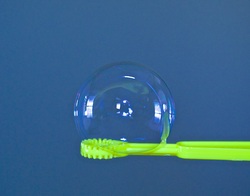 From childhood to adulthood, bubbles have never ceased to amaze me. From the simple bubble solution to magical air-filled bubbles that gently drift and softly swirl through the air, only to pop with a soft, fizzy, POP! It’s no wonder that children find them just as exciting and memorizing as I do. Because of the strong fascination of this age-old pastime, bubbles have become one of my favourite tools in speech and language therapy. It’s a playful pastime that is both motivating and entertaining for children of almost any age! I’m still discovering new and interesting ways to integrate bubbles into daily goals for the children I work with. Here are a few of my favourite ways to incorporate bubbles into daily routines to help build strong speech and language skills:
Even though your child may not be using words yet, you can still model words for them; and with the magical bubble wand in your hand, all eyes will be on you. Use single words and short phrases such as “More bubbles!” and “POP!”
Bubbles can also be used to teach...blowing bubbles! As simple as that sounds, most children aren’t born with the knowledge of how to blow bubbles. Blowing bubbles involves many different skills such as knowledge of cause and effect, the ability to imitate actions, and proper breath support, just to name a few! The important key in using bubbles effectively to help build speech and language skills is to be interactive with your child, and keep control of the bubbles. And of course, remember to have fun!
7 Comments
 All things Communication What does a Speech-Language Pathologist do? This is a question that I hear a lot. Most people are familiar with the “speech” portion, and many have told me they used to see a speech therapist when they were younger. There are a number of areas that encompass the work that Speech-Language Pathologists are capable of in order to help their clients meet their communication goals. Since I work with children, these areas are geared towards the younger population. It’s important to know that other Speech-Language Pathologists who work with the adult population may also cover other areas such as neurological problems or disorders associated with dementia or strokes. Speech: An SLP may work with children who are difficult for others to understand. This may include articulation, phonology and motor speech disorders. Language: An SLP may work with children who have delayed vocabulary and grammar skills, and have difficulty understanding language and/or following directions. Literacy: An SLP may work with children to build strong pre-literacy and literacy skills such as sound/phonological awareness and listening/reading comprehension. Social Language/Skills: An SLP may work with children to help develop social language and social skills such as turn-taking, eye-contact, cooperative play skills, as well as following the rules of conversational speaking and story-telling. Fluency: An SLP may work with children who stutter. Other: An SLP may also work with children who have communication and swallowing difficulties due to other problems. These issues may include brain injuries, hearing impairment, and other disabilities such as autism. For more information: The American Speech-Language-Hearing Association (ASHA): http://www.asha.org/public/ Speech-Language & Audiology Canada (SAC): http://www.sac-oac.ca/public/children |
AuthorAlyssa Bergen is a Speech-Language Pathologist who understands the power of communication. She enjoys working with young children and seeing how their lives are positively shaped by successful communication. ArchivesCategories
All
|
